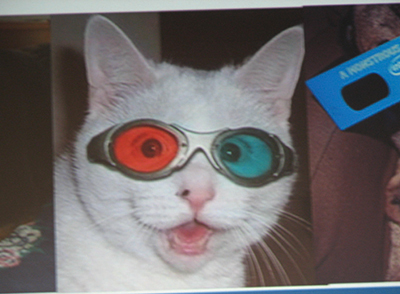
Tom Butts
Editor-in-Chief
tbutts@nbmedia.com
Has there ever been a tech burnout faster than 3DTV? If there is, please let me know.
Despite all the hype over the past couple years, 3DTV has quickly become the “Rodney Dangerfield” of television technology. Mention the format at any industry conference and watch the eyes quickly glaze over. “Nobody’s wants it,” “Glasses are too clunky,” are usually among the responses you’ll get.
It wasn’t that way just a few short years ago. At the height of the 3DTV hype in 2010, it was THE buzzword of the NAB Show as vendors attempted to demonstrate their commitment to making the format “the next great entertainment platform,” to quote one exhibitor. New 3D channels from ESPN, Comcast and Cablevision’s MSG network were launched while Sony teamed with Discovery and IMAX to launch the 24-hour channel “3net”; Panasonic and DirecTV joined forces to launch similar ventures. A number of pay-TV providers set aside channels to carry these 3DTV networks.
The format made its biggest impression in high-profile live sporting events including the Olympics, Super Bowl, March Madness, NASCAR, Wimbledon, etc. And then there were the head scratchers, including a 3D transmission of Queen Elizabeth’s Christmas address in 2012. Programmers also smartly aimed their 3D cameras at another natural 3D landscape: nature documentaries. Efforts by similar broadcasters overseas including BSkyB and the BBC in the U.K. haven’t seen much success either.
Perhaps smarting from their experience with HD when lack of content was the prime culprit for a sluggish rate of adoption, it seemed that programmers and consumer electronics manufacturers tried to provide a balance of 3DTV programming with consumer demand for the sets. But for the most part, consumers have reacted with a collective yawn to the format with complaints that are all too familiar to us now: not enough content and the glasses are inconvenient.
With 4K all the rage, 3DTV seems to be in danger of being left behind. And even some earlier proponents of the format have turned against it. Last month, the BBC reported that ratings decrease with the airing of every 3D broadcast now and has threatened its future on the world’s largest broadcast stage. “I don’t think we will see a 3D channel launch at all on the BBC,” one network official said at a conference, according to the website 3dfocus.co.uk.
The professional video industry's #1 source for news, trends and product and tech information. Sign up below.

Has 3DTV used up all its lives? Speaking at another London conference around the same time, Bob Zitter, retiring CTO at HBO, said “3D with glasses is ‘dead.’” “We never thought that 3D with glasses was ever going to get off the ground,” Zitter added, according to Rapid TV News. (Zitter also expressed similar skepticism with 4K).
Manufacturers haven’t had much success with the format either. Marco Lopez, the new president of Miranda, which was one of the earliest proponents of the format, was skeptical about demand among its broadcast customers. “It really hasn’t taken off,” he told TV Technology.
What killed it off? Was it the lack of marketing? The clunky glasses? Expensive sets? Probably a combination of all three plus more, including what could be 3DTV’s biggest weakness: the inability of more than a few TV fans being able to watch the same 3D program in the same room. When it came to the social aspects of television, 3DTV can be a bit of a buzzkill.
Not all hope is lost, however. Proponents such as James Cameron and Vince Pace continue to push forward with their innovative 3D production technology, although they’re likely to get better reception on the film side than television. There are reportedly more than 25 million 3DTV sets in American homes, according to 3net, which just celebrated its second anniversary in February by reporting that the channel was now available in more than 40 million U.S. homes. SMPTE continues to study and advocate the format, and while Peter Lude, the organization’s liaison for 3D, agrees that the format hasn’t taken off as well as expected, he believes there’s still a future for it in OTT. And it will also have a role in ATSC 3.0 as well.
But for now at least, 3D, a format with a rich, 100-plus year history, is a no-show for TV.
Tom has covered the broadcast technology market for the past 25 years, including three years handling member communications for the National Association of Broadcasters followed by a year as editor of Video Technology News and DTV Business executive newsletters for Phillips Publishing. In 1999 he launched digitalbroadcasting.com for internet B2B portal Verticalnet. He is also a charter member of the CTA's Academy of Digital TV Pioneers. Since 2001, he has been editor-in-chief of TV Tech (www.tvtech.com), the leading source of news and information on broadcast and related media technology and is a frequent contributor and moderator to the brand’s Tech Leadership events.

